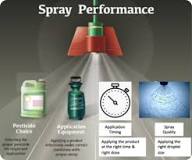Droplet size is highly important if pesticides are to be applied efficiently with minimal environmental contamination. Pesticidal sprays are generally classified according to droplet size.
Sprays contain numerous droplets, i.e., very small spheres of liquid, mostly less than 0.5 mm in diameter. Aerosol sprays are used primarily for drift spraying against flying insects.
Some aerosols (30–50 μm) and mists are ideal for treating foliage with Very Low Volume (VLV) and Ultra Low Volume (ULV) application rates.
When drift must be minimized, a medium or coarse spray is required, regardless of the volume applied. A fine spray is used when a compromise between reduced drift and good coverage is needed.
When selecting a specific droplet size for a particular target, consideration must be given to the movement of spray droplets or particles from the application equipment toward the target.
The influence of gravitational, meteorological, and electrostatic forces on droplet movement is affected by droplet size.
When the spray volume is reduced, effective coverage to control a sessile pest is achieved with a large number of small droplets.
Read Also: Gray Leaf Spot (Stemphylium spp) – Symptoms and Damage Control
Factors Influencing Pesticide Droplet Movement

1. Effect of Evaporation on Droplet Size
The surface area of spray liquid increases significantly when broken into small droplets, especially when the diameter is less than 50 μm. A droplet loses volatile liquid over this surface area.
The rate of evaporation decreases as the surrounding air becomes saturated. Changes in spray concentration due to non-volatile ingredients may lower the solvent’s vapor pressure.
Water, the principal diluent of pesticidal sprays and many organic solvents used in emulsifiable concentrates, is volatile.
The size of small droplets in water-based sprays decreases rapidly, leaving an aerosol droplet of involatile material or a particle, even in temperate conditions of 20°C with 80% relative humidity.
This reduction is faster under tropical conditions with higher temperatures and lower humidity.
2. Effect of Gravity on Droplet Movement
A droplet released in still air accelerates downward under gravity until the gravitational force is balanced by aerodynamic drag, resulting in a constant terminal velocity.
Terminal velocity is typically reached in less than 25 mm for droplets smaller than 100 μm and 70 cm for a 500 μm droplet. Droplet size, density, shape, and air density and velocity affect terminal velocity.
The most critical factor is droplet size. Due to low terminal velocities, droplets less than 30 μm in diameter take several minutes to fall in still air, exposing them longer to air movements.
Read Also: Recommended Number of Ruminant Animals per Housing Unit for Fattening
Impact of Meteorological Factors on Droplet Spread

The proportion of spray reaching the target is significantly influenced by local climatic conditions, requiring an understanding of meteorological factors affecting droplet movement near the ground.
Key factors include temperature, wind velocity, wind direction, and relative humidity. Air temperature is affected by atmospheric pressure, which decreases with height above ground, causing rising air to expand and cool without heat exchange.
Droplet Dispersal in Agricultural Spraying
A droplet follows a resultant direction based on the combined effects of gravity, mean wind velocity, and turbulence, which can be upward during convective conditions. This is evident when spray drifts over several rows during unstable conditions.
A large proportion of the spray may not be collected within the treated crop. Peak deposition of small droplets downwind is proportional to nozzle height and inversely proportional to turbulence intensity, whereas larger droplets are relatively unaffected by turbulence.
Types of Nozzles for Pesticide Application

A nozzle is a device through which spray liquid is emitted, broken into droplets, and dispersed over a short distance. Nozzles are classified by the energy used, e.g., hydraulic, gaseous, centrifugal, kinetic, and thermal.
Impact Nozzles for Herbicide Application
Impact nozzles produce a fan-shaped spray pattern with large droplets. Operated at low pressures, they are widely used for herbicide application to reduce small droplets prone to drift. When applying herbicides, the spray is typically directed downward.
Also called flooding, anvil, or deflector nozzles, they are used for nematicides, herbicides, and systemic insecticides in orchards and irrigation water.
1. Fan Nozzles for Surface Spraying
Fan nozzles are suitable for spraying flat surfaces like soil and walls. They are widely used on conventional tractor and aerial spray booms and compression sprayers for controlling mosquitoes in huts.
2. Cone Nozzles for Foliage Spraying
Cone nozzles are ideal for spraying foliage because droplets approach leaves from multiple directions, unlike the single plane produced by flat fan nozzles.
Do you have any questions, suggestions, or contributions? If so, please feel free to use the comment box below to share your thoughts. We also encourage you to kindly share this information with others who might benefit from it. Since we can’t reach everyone at once, we truly appreciate your help in spreading the word. Thank you so much for your support and for sharing!
Frequently Asked Questions
We will update this section soon.

